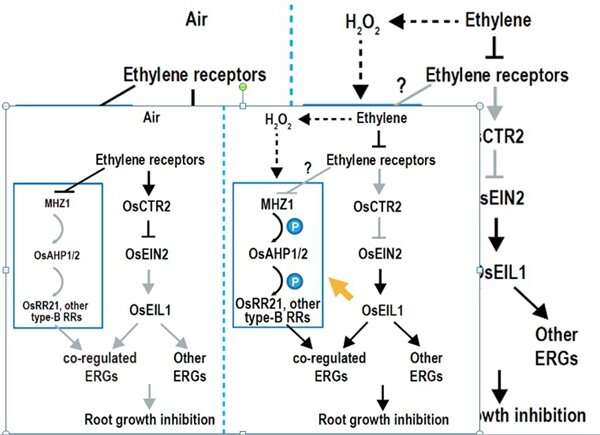A proposed working model for MHZ1-mediated ethylene signaling in rice. Credit: IGDB
Phytohormone ethylene plays essential roles in plant growth and development and response to stresses. In dicot Arabidopsis, the ethylene signaling pathway has been well-characterized. Ethylene signal is perceived and transduced through an ethylene receptor-CTR1-EIN2-EIN3/EIL1 pathway. In semiaquatic monocot rice, while ethylene plays essential roles in its adaptive responses to the hypoxia conditions and regulates multiple agronomic traits, its signaling mechanism is largely unclear.
Recently, a team led by Professors Zhang Jinsong and Chen Shouyi at the Institute of Genetics and Developmental Biology of the Chinese Academy of Sciences, revealed a novel ethylene signaling mechanism in rice roots.
Zhang and Chen's labs have developed an efficient system to identify rice ethylene signaling mutants. They have screened a set of rice ethylene response mutants which were named as mao huzi (mhz, Chinese name with an English meaning of cat whiskers), and identified conserved and novel components of ethylene signaling.
Among the mutants identified, a root-specific ethylene insensitive mutant mhz1 was characterized. They found that MHZ1 encodes a cytosolic histidine kinase OsHK1, which is homologous to Arabidopsis AHK5. Usually, histidine kinase-mediated signaling is more prevalent in bacteria.
Through biochemical experiments, they found that MHZ1 has autophosphorylation ability on a conserved histidine residue and transfers the phosphoryl groups to OsRR21 via OsAHPs, which is called the multistep phosphorelay. They proved that this MHZ1-mediated phosphorelay is essential for ethylene-regulated root growth.
Further, they found that ethylene receptor OsERS2 interacts with MHZ1 to suppress its kinase activity, and subsequently inhibits the MHZ1-mediated phosphorelay. This OsERS2-MHZ1-phosphorelay pathway functions partially independent of the conserved OsEIN2-OsEIL1 pathway to regulate ethylene response in rice roots.
This study revealed a novel ethylene signaling mechanism in rice roots, of which MHZ1 interacts with the ethylene receptors to regulate ethylene response. The discovery suggests that rice may have adopted a more complicated ethylene signaling mechanism than Arabidopsis to adapt to the water-saturated environment.
This paper entitled "Histidine kinase MHZ1/OsHK1 interacts with ethylene receptors to regulate root growth in rice" was published in Nature Communications on January 24, 2020.
More information: He Zhao et al. Histidine kinase MHZ1/OsHK1 interacts with ethylene receptors to regulate root growth in rice, Nature Communications (2020). DOI: 10.1038/s41467-020-14313-0
Journal information: Nature Communications
Provided by Chinese Academy of Sciences























